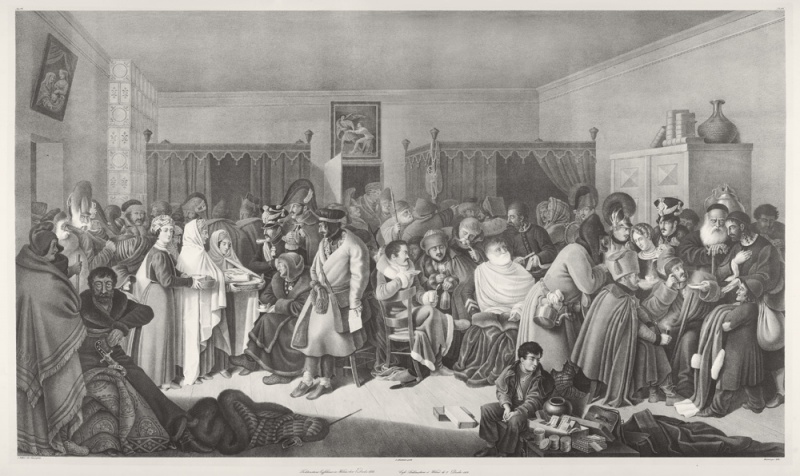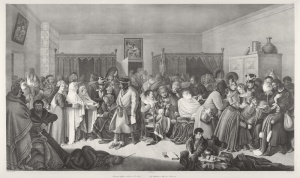
Lichtenstein’s Coffee House in Wilna on 7 December 1812
| Authors: |
Eberhard Emminger (1808–1885) Gottfried Küstner (1800–1864) Christian Wilhelm von Faber du Faur (1780–1857) |
| Created: | 1831–1844 |
| Material: | paper |
| Technique: | litograph |
| Dimensions: | 52 × 103 cm |
| Signature: | inscription: Nro.94 / Nro.95 / v. Faber du Faur gem., / G. Küstner gedr. / Emminger lith. / Lichtensteins Caffehaus in Wilna den 7 Decbr. 1812. / Café Lichtenstein à Wilna le 7. Decbr. 1812. |
Lithograph, after Christian Wilhelm von Faber du Faur. Christian Wilhelm von Faber du Faur, ‘Sheets from my Portfolio about the 1812 Military Campaign’, 1831–1844.
The German artist Christian Wilhelm von Faber du Faur (1780–1857) lived in Stuttgart, studied law and learned to paint. He admired Napoleon, and enrolled as a volunteer in the Army of Württemberg. He took part in the invasion of Russia by the French army in 1812 as an officer, and witnessed its catastrophic retreat. He sketched his impressions of the Russian campaign in a notebook, and used the drawings for his book Blätter aus meinem Portefeuille, im Laufe des Feldzugs 1812 (Sheets from my Portfolio about the 1812 Military Campaign), published between 1831 and 1844. The drawings for the publication were skilfully made into lithographs by the artists Eberhard Emminger (1808–1885) and Gottfried Küstner (1800–1864) from Stuttgart. Von Faber du Faur portrayed scenes from the march, battles and precise views of the terrain in great detail. Out of 100 lithographs, 40 are of the Grand Duchy of Lithuania, and 17 depict places in ethnographic Lithuania. Only one work shows Vilnius, Lichtenstein’s Coffee House in Wilna on 7 December 1812. That day, in temperatures of minus 20oC, the bedraggled, frozen and starving army reached the city. Most residents locked their doors and would not let the soldiers in, so they collapsed on the streets. Lichtenstein’s Coffee House was one of the places where they could take refuge. A room in the coffee house is full of Frenchmen, and the servants offer their services, bringing tea and trimming beards, and a Jewish vendor touts his wares. The German artist saw the people of Vilnius as friendly but rather exotic.
Text author Laima Laučkaitė
Source: Law firm Valiunas Ellex art album VILNIUS. TOPOPHILIA II (2015). Compiler and author Laima LaučkaitėExpositions: “Vilnius. Topophilia. Views of Vilnius from the collection of the law firm Ellex Valiunas”, 5 October – 26 November 2017, National Gallery of Art, Vilnius (curator Laima Laučkaitė) "Vilnius Time", 5 June 2023 – 1 May 2024, Lithuanian Art Centre TARTLE (Užupio St. 40, Vilnius). Curators Ieva Burbaitė and Emilija Vanagaitė.







